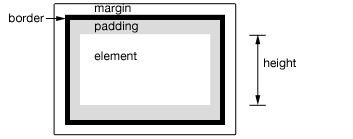.height()
Get the current computed height for the first element in the set of matched elements. Set the CSS height of every matched element.
.height()🡢 Number
The difference between .css( "height" ) and .height() is that the latter returns a unit-less pixel value (for example, 400) while the former returns a value with units intact (for example, 400px). The .height() method is recommended when an element's height needs to be used in a mathematical calculation.

This method is also able to find the height of the window and document.
// Returns height of browser viewport
$(window).height();
// Returns height of HTML document
$(document).height();
Note that .height() will always return the content height, regardless of the value of the CSS box-sizing property. As of jQuery 1.8, this may require retrieving the CSS height plus box-sizing property and then subtracting any potential border and padding on each element when the element has box-sizing: border-box. To avoid this penalty, use .css( "height" ) rather than .height().
Note: Although style and script tags will report a value for .width() or height() when absolutely positioned and given display:block, it is strongly discouraged to call those methods on these tags. In addition to being a bad practice, the results may also prove unreliable.
Show various heights. Note the values are from the iframe so might be smaller than you expected. The yellow highlight shows the iframe body.
<button id="getp">Get Paragraph Height</button>
<button id="getd">Get Document Height</button>
<button id="getw">Get Window Height</button>
<div></div>
<p>Sample paragraph to test height</p>
body {
background: yellow;
}
button {
font-size: 12px;
margin: 2px;
}
p {
width: 150px;
border: 1px red solid;
}
div {
color: red;
font-weight: bold;
}
function showHeight(element, height) {
$("div").text("The height for the " + element + " is " + height + "px.");
}
$("#getp").click(function () {
showHeight("paragraph", $("p").height());
});
$("#getd").click(function () {
showHeight("document", $(document).height());
});
$("#getw").click(function () {
showHeight("window", $(window).height());
});
.height(value)🡢 jQuery
value
| String, Number | An integer representing the number of pixels, or an integer with an optional unit of measure appended (as a string). |
.height(function(indexInteger, heightInteger))
function(indexInteger, heightInteger)
| Function | A function returning the height to set. Receives the index position of the element in the set and the old height as arguments. Within the function, this refers to the current element in the set. |
When calling .height(value), the value can be either a string (number and unit) or a number. If only a number is provided for the value, jQuery assumes a pixel unit. If a string is provided, however, a valid CSS measurement must be provided for the height (such as 100px, 50%, or auto). Note that in modern browsers, the CSS height property does not include padding, border, or margin.
If no explicit unit was specified (like 'em' or '%') then "px" is concatenated to the value.
Note that .height(value) sets the content height of the box regardless of the value of the CSS box-sizing property.
To set the height of each div on click to 30px plus a color change.
<div></div>
<div></div>
<div></div>
<div></div>
<div></div>
div {
width: 50px;
height: 70px;
float: left;
margin: 5px;
background: rgb(255, 140, 0);
cursor: pointer;
}
$("div").one("click", function () {
$(this).height(30).css({
cursor: "auto",
backgroundColor: "green",
});
});